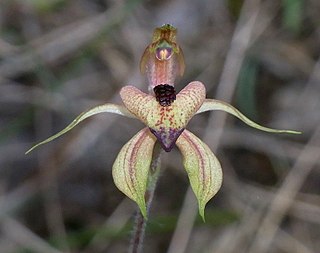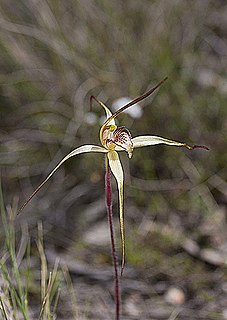Caladenia ancylosa, commonly known as the Genoa spider orchid, is a plant in the orchid family Orchidaceae and is endemic to Victoria. It is a ground orchid with a single hairy leaf and a single cream-coloured flower with red markings.
Caladenia atroclavia, commonly known as the black-clubbed spider orchid, is a plant in the orchid family Orchidaceae and is endemic to south-eastern Queensland. It is a ground orchid with a single hairy leaf and a pale greenish-cream coloured flower with dark purple clubs and red patches on the petals.

Caladenia calcicola, commonly known as the Bats Ridges spider orchid, is a plant in the orchid family Orchidaceae and is endemic to a small area near the Victoria - South Australia border. It is a ground orchid with a single hairy leaf and one or two glossy, pale yellow flowers with maroon markings.

Caladenia cardiochila, commonly known as thick-lipped spider-orchid, fleshy-lipped caladenia and heartlip spider-orchid, is a plant in the orchid family Orchidaceae and is endemic to Victoria and South Australia. It is a ground orchid with a single hairy leaf and one or two yellowish-green, red-striped flowers on a thin, wiry stem.
Caladenia colorata, commonly known as coloured spider-orchid, small western spider-orchid and painted spider-orchid is a plant in the orchid family Orchidaceae and is endemic to South Australia and possibly Victoria. It is a ground orchid with a single hairy leaf, and usually a single creamy-green flower with blood-red or purple-brown markings and with dark tips on the petals and sepals.
Caladenia cremna, commonly known as Don's spider orchid, is a plant in the orchid family Orchidaceae and is endemic to a small area in Victoria. It is a rare ground orchid with a single hairy leaf and a single yellow flower with red striations.

Caladenia echidnachila, commonly known as the fawn spider orchid, is a plant in the orchid family Orchidaceae and is endemic to Tasmania. It is a ground orchid with a single, hairy leaf and one or two fawn-coloured flowers with thin red lines on the sepals and petals.
Caladenia flaccida, commonly known as the flaccid spider orchid, is a plant in the orchid family Orchidaceae and is endemic to eastern Australia. It is a ground orchid with a single hairy leaf and up to three cream-coloured, pinkish or red flowers with long, thread-like, glandular tips on the sepals and petals.

Caladenia fulva, commonly known as the tawny spider orchid, is a plant in the orchid family Orchidaceae and is endemic to a small area in Victoria. It is a ground orchid with a single hairy leaf and one or two creamy-white to pale yellow flowers. Only two small populations are known, although both are in nature reserves.
Caladenia hastata, commonly known as Mellblom's spider orchid is a plant in the orchid family Orchidaceae and is endemic to Victoria. It is a ground orchid with a single hairy leaf and up to three white to cream-coloured flowers with red markings on the labellum.
Caladenia insularis, commonly known as French island spider orchid is a plant in the orchid family Orchidaceae and is endemic to Victoria. It is a ground orchid with a single leaf and usually only one cream-coloured, pink or pale yellow flower, heavily streaked with red. It is only known from French Island.
Caladenia lindleyana, commonly known as the Lindley's spider orchid is a species of orchid endemic to Tasmania. It has a single, hairy leaf and one or two greenish-yellow flowers tinged with red and with thin dark tips on the sepals. Very few plants of this species survive with only one plant, which has not been seen since 1997, protected in a reserve.

Caladenia montana, commonly known as the mountain spider orchid is a plant in the orchid family Orchidaceae and is endemic to New South Wales, Victoria and the Australian Capital Territory. It is a ground orchid with a single leaf and a single greenish-cream to cream flower, sometimes with reddish markings. It only grows in high montane forests.
Caladenia patersonii is a plant in the orchid family Orchidaceae and is native to Victoria and Tasmania. It is a ground orchid with a single hairy leaf and one or two creamy-white, yellowish or pink flowers.
Caladenia richardsiorum, commonly known as the little dip spider orchid, Richards' spider orchid or robe spider orchid, is a plant in the orchid family Orchidaceae and is endemic to South Australia. It is a ground orchid with a single erect, hairy leaf and usually only one yellowish-green flower. It is similar to the endangered Mellblom's spider orchid but has a much larger leaf and the petals lack glandular tips.

Caladenia tensa, commonly known as the rigid spider orchid is a plant in the orchid family Orchidaceae and is endemic to southern continental Australia. It is a ground orchid with a single leaf and one or two pale green flowers with red stripes. It is mainly only found in the Little Desert National Park in Victoria and in the far south-east of South Australia but there are four records from New South Wales.

Caladenia valida, commonly known as the robust spider orchid, is a plant in the orchid family Orchidaceae and is endemic to south-eastern continental Australia. It is a ground orchid with a single sparsely hairy leaf and up to three white to cream-coloured flowers which sometimes have red streaks. It is similar to Caladenia reticulata but is large and taller with more stiffly spreading lateral sepals and petals.
Caladenia woolcockiorum, commonly known as Woolcock's spider orchid, is a species of orchid endemic to South Australia. It has a single, long, erect, hairy leaf and one or two cream-coloured to greenish-yellow flowers recognised by their long, drooping lateral sepals and petals with their ends having dark glandular tips and by the red-tipped labellum.
Caladenia armata is a plant in the orchid family Orchidaceae and is endemic to the Australian Capital Territory. It has a single dull green leaf with purple blotches near the base, and a single cream-coloured to pink flower with red to maroon markings. It is only known from a single population containing fewer than ten plants.
Caladenia douglasiorum is a plant in the orchid family Orchidaceae and is endemic to central Victoria in Australia. It is a ground orchid with a single hairy leaf and a single greenish-cream to yellowish flower with red marks.








